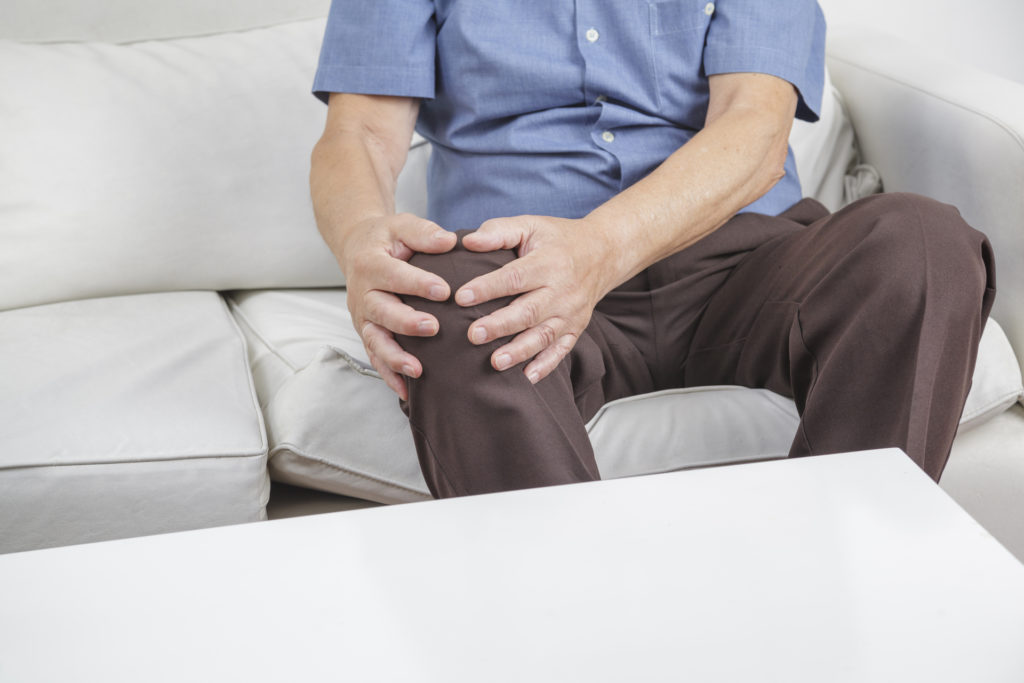Bone & Joint Health
7 Potential Symptoms of Osteoarthritis
Over 30 million Americans live with osteoarthritis. It is now the number one cause of disability in the United States1,2. Osteoarthritis is the wear and tear of the joints that happens over time (and usually affects older individuals). Those who suffer from osteoarthritis may have one or more of the following symptoms:
Pain
This is the main symptom for most osteoarthritis sufferers. Pain is centered around the joint and is usually made worse during or after movement. In some cases, the pain may be bad enough to prevent you from carrying out your normal day-to-day activities. Tips for dealing with joint pain include:
- Pain medications like non-steroidal anti-inflammatory drugs (NSAIDs) and acetaminophen
- Alternative therapies like massage and physiotherapy
- Traditional joint supplements like glucosamine and chondroitin or less common ones like quercetin (an antioxidant that doubles up as an anti-inflammatory) or bromelain (a protein extract derived from pineapple)
- Hot and cold therapy (long, warm showers or baths—especially in the morning—help ease stiffness in the joints. Using an electric blanket or moist heating pad at night may also help.)
Don’t be afraid to try a combination of these pain relief treatments. Sometimes it takes more than one approach to get through pain relief.
Tenderness
Next to pain, tenderness is another common symptom. The joint may feel tender when you apply light pressure and may be accompanied by redness and swelling. You may find that ice packs, heating pads, or pain creams applied directly to the joint may help.
Stiffness
Joint stiffness is most noticeable when you wake up in the morning or after a period of inactivity. It usually gets better as the day goes on or with light movement.
Unfortunately, stiffness of the joint usually gets worse with time as the disease progresses. To combat joint stiffness, think about starting up moderate exercise. It is one of the most effective ways to treat osteoarthritis. Exercise has been shown to reduce pain, improve flexibility, and strengthen the muscles that support the joints3.
Loss of flexibility
With osteoarthritis, you may not be able to move your joint through its full range of motion. This means your range of movement is limited and moving your joint left, right, or rotating it around may be painful. If the arthritis is in your lower legs or upper arms, then a visit to the physical therapist might be in order. Physical therapists can recommend flexibility or range-of-motion exercises that help to increase both.
Additionally, for larger joints like the shoulders and knees, weight-bearing exercises that build up the supporting tendons and ligaments around the joint may also help with flexibility.
Grating sensation
You may hear or feel a grating sensation when you use the affected joint. This happens when the bones in your joint start to rub against one another and needless to say, this is not a good sign. Osteoarthritis occurs when the cartilage that cushions the ends of bones in a joint gradually deteriorates. Even with the best treatments. this deterioration may continue to the point where the cartilage wears down completely, and you are left with is bone rubbing on bone.
If this should happen, then it is time to speak to your doctor or surgeon. A more permanent solution like surgery may be needed.
Other Symptoms
Bone spurs
Joint damage and inflammation are the main causes of bone spurs. They can sometimes go undetected and require no treatment. Others can cause pain and discomfort. The bone spurs occur where bones meet together which mean they occur in your joints.
Limping
If you suffer from arthritis in your load-bearing joints, like your knees, you may develop a limp. As your cartilage continues to break down, the limping can become more noticeable. If your osteoarthritis is not severe, you may be able to reduce the limping by reducing joint pain and stiffness. If your osteoarthritis is severe, talk to your doctor about procedure options.

What are your options?
Nutrition
Osteoarthritis can stem from many different scenarios. Because of your genetics, you may be more susceptible to OA. It may be caused by wear-and-tear from a taxing occupation. You may have sustained an injury that led to developing OA. Or your osteoarthritis might just be part of the aging process. No matter the underlying reason, nutrition will be a key part in managing your symptoms.
Glucosamine/Chondroitin: Glucosamine and chondroitin are building blocks of healthy cartilage. Glucosamine plays a big role in delaying the progression of osteoarthritis. It is considered a symptom-modifying nutrient, meaning not only does it help delay the seriousness of the disease but delays related symptoms as well.
Chondroitin, much like glucosamine, can also help reduce joint pain in those with osteoarthritis. Chondroitin can also help reduce swelling and joint effusion. Your joints are surrounded by what is known as synovial fluid. This fluid helps keep your joints lubricated. When the levels of synovial fluid are higher than average, it causes inflammation and even infection (joint effusion).
Antioxidants: Free radicals are unstable molecules that cause damage to neighboring cells. This damage plays a key role in the progression of osteoarthritis. Without antioxidants, free radicals can severely damage your cartilage. However, with antioxidants like vitamin A, C, E and selenium, you can help prevent or reduce the cartilage damage.
Omega-3s: The most common forms of omega-3s used for joint health are DHA and EPA. These nutrients help reduce inflammation, swelling, and joint pain. They keep your joints well-lubricated allowing for better flexibility and range of motion.
Hyaluronic acid: This nutrient helps maintain the lubrication and mechanics of your joints. Without it, your joints will not function properly. It has also been shown to ease joint pain associated with osteoarthritis.
Quick Nutrition Tips
- Eat lots of fruits and vegetables, especially bright berries and leafy greens. They can help reduce inflammation and joint pain.
- Vitamin C is a powerful antioxidant that can help reduce the damage done by free radicals. Eat a lot of citruses, pineapple, cantaloupe, and kiwi.
- If weight management is necessary, try these three things:
- Don’t eat out. Stick to homemade meals.
- Eat smaller portions.
- Opt for foods that don’t have high caloric value.
- Eat seafood! Seafood, like cod and shrimp, provides vitamin D which can help slow the breakdown of cartilage. And try some salmon as it provides omega-3 fatty acids which help reduce inflammation.
Medication
The most common medications used to treat OA symptoms are NSAIDs (Non-steroidal anti-inflammatory drugs). Here are some of the most common NSAIDS:
Ibuprofen. You have most likely taken Ibuprofen for headaches and other aches and pains. Ibuprofen inhibits the pain and inflammation caused by OA by reduces the hormones that cause inflammation. If over-the-counter ibuprofen does not seem to be strong enough, your doctor can prescribe you a higher does.
You have probably taken Ibuprofen for headaches and common aches and pains. Similar to other NSAIDs, Ibuprofen inhibits pain and inflammation by reducing the hormones that cause inflammation. If taking over-the-counter Ibuprofen does not seem to help your pain, your doctor can prescribe a higher dose.
Celebrex. Similar to other NSAIDs, Celebrex helps improve joint pain and stiffness. As an additional benefit, Celebrex can cause fewer stomach problems than other anti-inflammatory medications.
Naproxen. The active ingredient in medications like Aleve, naproxen reduces the hormones that cause pain and inflammation. Naproxen is an anti-inflammatory and is often prescribed to treat joint swelling and discomfort.
Diclofenac. In addition to treating mild to moderate pain for arthritis patients, Diclofenac is prescribed for many conditions such as migraines, multiple forms for arthritis, and gall and kidney stone pain.

Weight loss
Your joints bear your weight. The more weight they have to bear, the more susceptible your joints are to break down. Excess weight puts a strain on your joints, especially on your knees and hips. Weight management is a key part of osteoarthritis treatment. Inadequate nutrition, overeating, and lack of exercise can all lead to excessive weight gain. Eating a well-balanced diet and moving your body will only improve your symptoms.
Exercise & Improving Flexibility
Even if you maintain a healthy weight, you should still stretch and exercise (under the direction of your doctor). Exercise is a key part of managing osteoarthritis. In fact, it is considered the most effective non-drug treatment. Adequate exercise can help you:
- Strengthen your muscles to help support affected joints
- Manage your weight
- Reduce stress and unnecessary tension in your joints
- Improve your range of motion and flexibility
Work with your doctor and a physical therapist to develop a specific exercise plan to support your OA. Doing so will help improve your stiffness, pain, and inflammation.
Procedures
There are a few different procedural options used to help treat osteoarthritis.
Injection Therapy
If you aren’t quite yet at the point of needing surgery but your OA is still causing difficulty, injection therapy might be the answer. Common types of injection include:
- Corticosteroids
- Viscosupplementation
- PRP (Platelet Rich Plasma)
- Stem cells
Injection therapy can help target specific areas of inflammation and pain. Some are used in the hopes of regenerating damaged tissue and creating new cells.
Surgery
There are a few different surgical procedures that can help with OA.
Arthroscopy. Used by surgeons to visualize, diagnose, and treat joint-related problems. The word arthroscopy comes from two Greek words: arthro (joint) and skopein (to look). The purpose of this procedure is to reach a diagnosis and determine the method of treatment.
Partial and Total Replacement Surgery. Replacement surgery is often necessary when other avenues of treatment have been exhausted. Knee replacement surgeries are the most common. The knee contains three compartments. In a partial replacement, the surgeon removes only the affected compartment. In a total replacement, all the compartments are replaced and ligaments are removed.
Shop Forte Supplement Products
1- CDC. Osteoarthritis. https://www.cdc.gov/arthritis/basics/osteoarthritis.htm
2- University of Maryland medical center. Osteoarthritis. Last reviewed on 2/3/2016. http://www.umm.edu/health/medical/altmed/condition/osteoarthritis
3- Harvard health. New ways to beat osteoarthritis pain. Published: May 2013. https://www.health.harvard.edu/pain/new-ways-to-beat-osteoarthritis-pain



Good morning,
I just purchased your Joint Am/PM supplements. Is it okay to take them in the morning with my breakfast and coffee. Looking forward to feeling better with these as I’ve read so much positive reviews.
Thank you,
Armina Vazquez